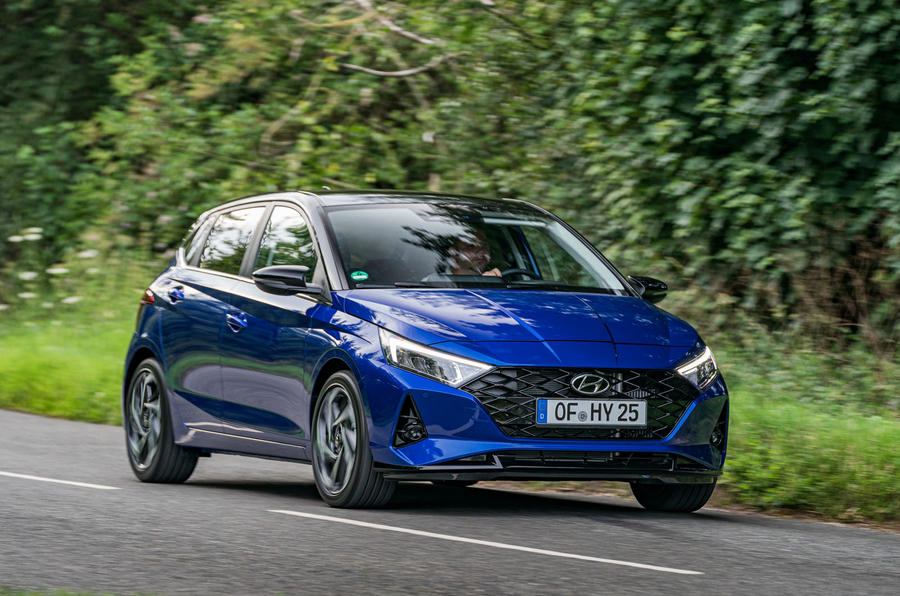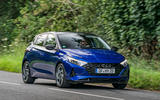Say hello to the new, third-generation Hyundai i20, driven here in the UK for the first time in not-quite-finished pre-production guise.
A definitive Hyundai first drive report will have to wait until we can get our hands on an example with a properly finished interior, production-spec noise, vibration and harshness (NVH) measures and a correctly calibrated gearbox. But for now, this left-hooker should give us a reasonably accurate idea of what we can expect from the new i20 when it officially goes on sale later this year.
Stylistically, the latest i20 represents a fairly dramatic departure 2021 from its 2015-2020 Hyundai i20 predecessor. Whereas the previous one was a handsome but relatively plain-looking thing to behold, this latest version is much more radical. Hyundai’s rather curiously titled ‘Sensuous Sportiness’ design language is to blame here, introducing sharper surface treatments, a lower roofline and a wider body to endow this new i20 with a rather more aggressive stance than it had before.
It’s longer now too, both nose-to-tail and between the wheels, which should bode well for passenger and luggage space. Either way, the foundation for the forthcoming Hyundai i20 N hot hatch certainly looks to be a pretty strong one.
Until that performance model arrives, the i20 engine line-up is pretty run of the mill. The UK offering hasn’t been finalised yet, but everything revolves around two different engines and four gearbox choices. An 83bhp 1.2-litre four-cylinder petrol kicks proceedings off at the entry-point to the range and is paired with a five-speed manual 'box. Then there’s the 99bhp 1.0-litre turbocharged three-pot, which is available with either a seven-speed dual-clutch automatic or a six-speed manual.
That 99bhp 1.0-litre engine is also available with a 48-volt mild-hybrid system as an option, and there’s a 118bhp version too. The 118bhp unit has the 48v system as standard, and is the car we’re testing here. It uses a seven-speed dual-clutch ‘box to drive the front wheels, although Hyundai’s newly-developed six-speed ‘Intelligent Manual’ is also available. The South Korean manufacturer hasn’t confirmed how this affects things like system power and torque outputs, but a 3-4% reduction in fuel consumption and CO2 emissions is a byproduct of having it fitted.






































Join the debate
Add your comment
It seems to be missing a front bumper
Expensive if you have a bump ☹️
Since i started
Since i started with my online business i earn $90 every 15 minutes. it sounds unbelievable but you wont forgive yourself if you don't check it out. <(")
Copy Here.........>> Www.lifestylesreview.Com۵
Please Remove ( ۵ ) when copy url
Another promising model
It is fairly easy to find some fault with low cost cars are inevitably compromises have to be made because of price and size but one thing you cannot dispute us that with each successive generation of Hyundai or Kia they get closer to the best European car standards. They have long shown more design flair than the Japanese makers and are more competitively priced. Now a much better proposition than most Toyota's and Honda's. I believe I read that they expect to be making 1million pure EV's a year within 5 years. I'm becoming a fan even if they still fall short of the dynamics of the recent Ford's and lack the brand (snob?) appeal of a VW.
Another promising model
It is fairly easy to find some fault with low cost cars are inevitably compromises have to be made because of price and size but one thing you cannot dispute us that with each successive generation of Hyundai or Kia they get closer to the best European car standards. They have long shown more design flair than the Japanese makers and are more competitively priced. Now a much better proposition than most Toyota's and Honda's. I believe I read that they expect to be making 1million pure EV's a year within 5 years. I'm becoming a fan even if they still fall short of the dynamics of the recent Ford's and lack the brand (snob?) appeal of a VW.